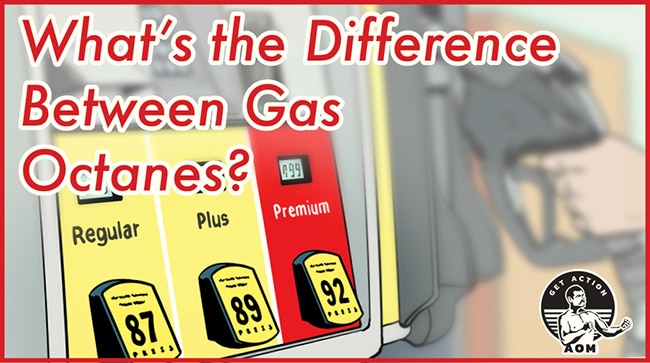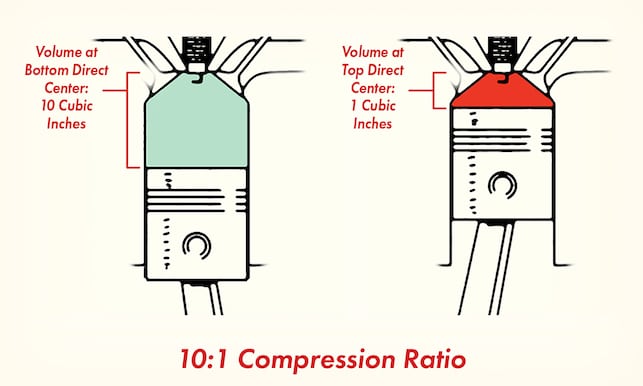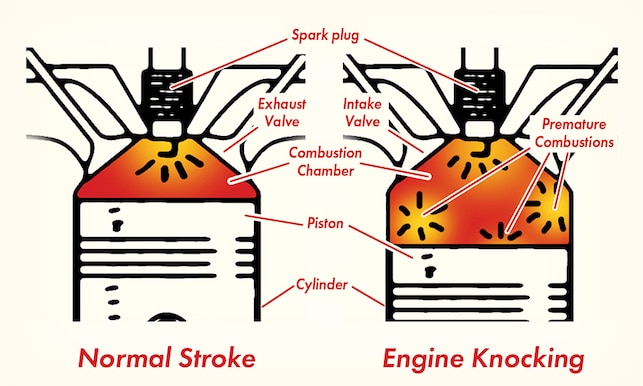
I’ve been driving for 25 years. I’ve likely filled up a car’s gas tank some 1,300 times during that stretch.
Every time I fill up a car at the gas pump, I’m met with three different fuel choices with varying levels of octane: 87, 89, and 93 (or 91/92). These different octane levels are usually labeled “Regular,” “Plus,” and “Premium, respectively.
I’ve always gone with regular unleaded gasoline because all the cars I’ve driven indicated that I should do so. I’ve known that some fancy luxury cars like Porsches and Mercedes required Plus or Premium, but I never understood why.
So I decided, after 25 years of not knowing what it meant for fuel to have different octanes, to finally acquire this bit of knowledge.
Today I’ll pass it along to you. Here’s the layman’s guide to what’s going on at the fuel pumps.
To Understand Octane Levels, You Need to Understand Engine Compression Ratios
Before we dig into fuel octanes, we need to understand engine compression ratios. In our article on how an internal combustion engine works, we explained the four-stroke cycle that powers your vehicle:
Intake Stroke
The piston lowers in the combustion cylinder, sucking air into it through the intake valve while the fuel injector simultaneously sprays fuel into the cylinder.
Compression Stroke
The valves close, and the crankshaft moves the piston up, compressing the air-fuel mixture.
Combustion Stroke (Power Stroke)
When the piston reaches the top, the spark plug sparks, igniting the fuel-air mixture. The resulting combustion forces the piston to the bottom of the cylinder again.
Exhaust Stroke
When the piston reaches the bottom, the exhaust valve opens up. The piston comes back up, forcing the exhaust out of the cylinder.
Compression ratio is a measure of how much the engine squishes the air-fuel mixture before it ignites it, creating the combustion that forces the piston to the bottom of the cylinder again.
Here’s an analogy to help you understand this:
Imagine you have a big empty soda can. Let’s say you pour some liquid into it, up to a quarter of its height, and then squish the can until it’s also a quarter of its original height. The liquid now resides in a much smaller space. Now imagine the squished space is our engine cylinder, and the liquid is the air-fuel mixture.
The compression ratio is a way to describe how much squishing happens. It’s the ratio between the volume of the space when the piston is down (called Bottom Dead Center, or BDC) and the space is biggest, to the volume of space when the piston is up (called Top Dead Center, or TDC) when the space is smallest.

So, if the space is ten times bigger when the piston is down compared to when it’s up, we say the compression ratio is 10:1. The bigger this number, the more the engine squishes the air and fuel together.
Most engines in passenger cars manufactured in the past 20 years have compression ratios that range from 8:1 to 12:1.
So why do some cars have higher compression engines? What’s the benefit?
I liked the explanation Dr. Andy Randolph, Technical Director at ECR Engines, gave to Jalopnik:
From a layman’s perspective, engine power is generated when combustion exerts a force on the piston and pushes the piston down the cylinder during the expansion stroke.
The higher the piston is in the bore when combustion begins, the more force will be exerted.
As compression ratio increases, the piston moves higher in the bore, hence there is additional force for the expansion stroke (additional force for the same amount of fuel equals higher efficiency).
Basically, cars that ignite the fuel-air mixture at a higher compression will have more power and are more fuel efficient than cars with lower engine compression.
High Octane Gasoline Is For Engines With a High Compression Ratio
Alrighty. So now we understand that engines with high compression cram more fuel-air mixture into the same small space during the compression stroke of the four-stroke engine cycle. We’re ready to bring in fuel octanes.
For the four-stroke engine cycle to work, timing is everything.

If the air-fuel mixture ignites too early during the compression stroke, you’ll create “knocking.” Knocking is no bueno. An early explosion creates a knocking or pinging sound in your engine. Your engine is offbeat. Over time, if this premature explosion or knocking keeps happening, it can cause wear and tear or even damage your engine.
High compression increases your risk of knocking because gasses heat up when compressed. As the air-fuel mixture gets squeezed into a small space in a high-compression engine, it heats up and could prematurely combust before the spark plug ignites it.
Many engines today have knock monitors that adjust the engine’s timing if it recognizes knocking going on.
But it would be better just to avoid engine knocking in the first place.
That’s where those different fuel octanes come in.
Fuels with higher octane can withstand more compression before igniting.
So, if you have a car with a high-compression engine, you need to use the gas with the higher octane. If you don’t, you’ll experience engine knocking.
How does a fuel company increase the octane level in a gas?
Basically, it mixes additives into the fuel that will make it more resistant to combusting under pressure.
Here’s an important point about octane levels:
Octane rating does not relate directly to the power output or the energy content of the fuel per unit mass or volume.
89 and 93 octane-level fuels have the same amount of energy.
The octane level simply indicates the gasoline’s resistance to igniting against compression.
That’s it.
Which Octane Gasoline Should You Use?
Use whatever octane level of gas the car manufacturer tells you to use.
They tell you in different places.
First, in your owner’s manual. It will tell you straight up what octane fuel to use.
The second place to check is your fuel gauge. You’ll usually see “Unleaded Fuel Only.” If you see that, you can use 87 octane level fuel. Sometimes, you’ll see “Premium Fuel Required.” If that’s the case, you have a car with a high-compression engine, so you need to use the higher octane fuel.
If you have a car that just needs 87 octane level gas, you won’t benefit from using a higher octane level fuel. Your car’s engine has a lower compression ratio, so the risk of the fuel-air mixture igniting before the spark plug fires is nil. You don’t need a gas with a higher resistance to combustion. Higher-octane gasoline won’t give you more power or improve your gas mileage. You’d need an engine with a higher-compression ratio to get those benefits. You’d be wasting your money using a higher-octane fuel.
But if you have a car with a high compression ratio engine, you need to use the higher octane fuel. If you use the lower octane gas to save money, you’re setting yourself up to experience engine knocking and damage.
Sometimes, you’ll see cars that say “Premium Gas Recommended.” You can use regular unleaded or premium. Premium may improve your car’s performance a little, but it will work fine with regular unleaded.
There you go. That’s what those differences in gas octane levels mean. It indicates the fuel’s resistance to combusting prematurely. Use the higher octane fuels for engines with high combustion ratios, as you see in luxury or performance vehicles; stick to regular unleaded for most cars.
The post What’s the Difference Between Gas Octanes? appeared first on The Art of Manliness.
0 Commentaires